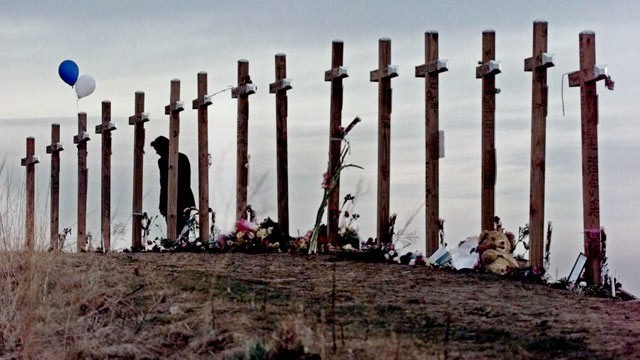Mass School Shootings: A History
This April 28, 1999 file photo shows an
unidentified woman with 15 crosses posted on a hill above Columbine High School
in Littleton, Colo. on April 28, 1999 in remembrance of the 15 people who died
during a school shooting on April 20. (Eric Gay/AP Photo)
By LAUREN
EFFRON (@LEffron831)
Dec. 14, 2012
As the numbers of the
dead from a Newtown, Conn., elementary school shooting climbed into the double
digits, it's hard not to remember that we have been here before.
The Sandy Hook
elementary school shooting is the deadliest at a high school or grade school in
the history of the country, but it is far from the first. Several mass school
shootings have speckled our recent history.
Thirteen years ago,
the small community of Littleton, Colo., was rocked by a massacre at Columbine
High School. Gunmen Eric Harris, 18, and Dylan Klebold, 17, walked into their
school on April 20, 1999, and opened fire, killing 12 of their classmates and a
teacher, and injuring 21 more, before turning their firearms on themselves.
At the time, it was
dubbed the most deadly school shooting in American history, and it changed the
way many communities across the country thought about school safety.
But then the nation
was once again rocked to its core when a gunmen went on a terrorizing rampage
at Virginia Tech, almost a decade later.
On April 16, 2007,
Virginai Tech senior Seung-Hui Cho unleashed a rampage
on the college campus, shooting and killing 32 students, and wounding 17 more
people. More than a year before the massacre, in December 2005, a district
court in Montgomery County, Va., deemed Cho "mentally ill" and "an imminent
danger to self and others."
The aftermath of the Virginia Tech shooting prompted Congress and President George W. Bush to sign the first major change to U.S. gun laws in more than 10 years -- it expanded the federal background check database -- and overhauled how the way many campuses handled crime and security alerts.
Before these rampages,
there were multiple other fatal school shootings. The death toll wasn't as
high, but the violence was just as great.
This year, on Feb. 27, T.J. Lane, 18, allegedly entered Chardon High
School in Ohio with a .22 caliber handgun and a knife. He shot four students in
the cafeteria and one in the hallway before walking out, leaving three dead.
Police detained him within a mile of the school. He remains in custody and is
expected to stand trial for the shootings in January.
On Oct. 2, 2006, a
gunman took about a dozen girls hostage, killing at least three of them, at a one-room Amish schoolhouse in Pennsylvania's Lancaster
County, police said. The shooter was among the dead when police
arrived.
On March 21, 2005, 16-year-old Jeff Weise shot and killed
five classmates, a teacher and an unarmed guard at a high school on the Red
Lake Indian Reservation in Minnesota, where about 5,000 Native Americans live,
before taking his own life. Weise had killed his grandfather and his
grandfather's companion before heading to school that day.
Between 1997 and 1998,
there were three school shootings within a few months of one another.
On May 21, 1998, two
teenagers were killed and more than 20 people were hurt when 15-year-old Kip
Kinkel opened fire at a Thurtson High School in Springfield, Ore.,
after killing his parents. Kinkel was sentenced to nearly 112 years in prison.
On March 24, 1998, two
boys, ages 11 and 13, fired on their Jonesboro, Ark., middle school from nearby
woods after pulling the fire alarm, killing four girls and a teacher, and
wounding 10 others. Both boys were later convicted of murder and were incarcerated
until they turned 21.
On Dec. 1, 1997, three
students were killed and five wounded at Heath High School in West Paducah, Ky.
Michael Carneal, 14, and a freshman, later pleaded guilty but mentally ill to
murder charges and is serving life in prison. He is eligible for parole in
2023.
One of the most iconic
school shootings in American history remains at Kent State Univeristy in Ohio.
On May 4, 1970, Ohio National Guard troops opened fire to quell an anti-Vietnam
War demonstration, killing four students and wounding nine others. The shooting
became known as the May 4 Massacre
Peter’s
Piece
America must be almost unique in the world with its
attitude about guns.
Elsewhere, logic dictates that carrying a gun for
personal protection does not make one safer. It will only heighten the risk of
dying of gunshot wounds.
But in spite of this a majority of Americans are in
love with guns, and gun laws will not change until a clear majority of
Americans campaign for radical change.












